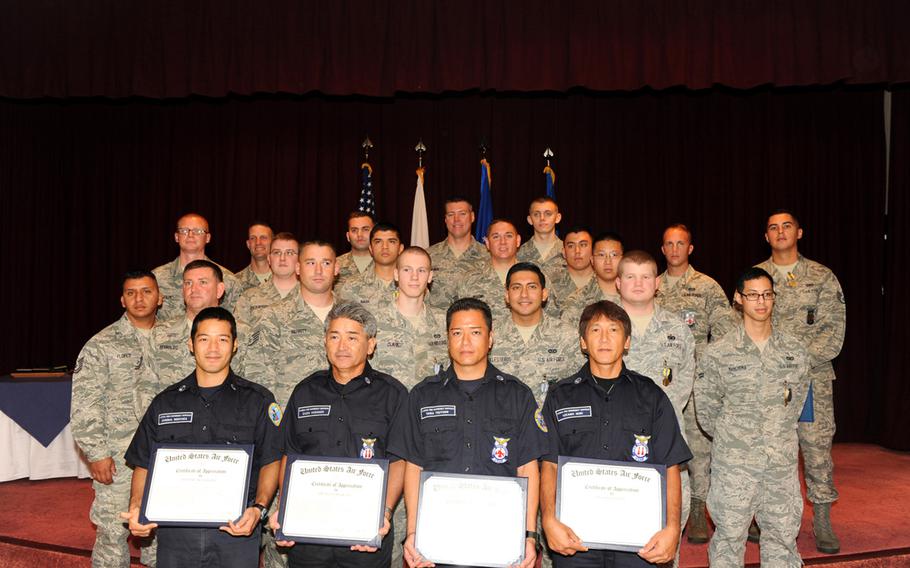
U.S. military and Japanese civilian first responders stand for a group photo after receiving Air Force Commendation medals, Air Force Achievement medals or outstanding achievement awards from U.S. Air Force Brig. Gen. James Hecker, 18th Wing commander, on Sept. 12, 2014. The group was responsible for rescuing two trapped airmen from a flooding guard shack during typhoon Neoguri on July 9, 2014. (Stephen G. Eigel/ U.S. Air Force)
Camp Foster, Okinawa — July 9, 2014
Airmen Brandon Miles and Roderick Jones were running out of time.
The pair had been on duty July 9, 2014, at a Kadena Air Base guard shack in Okinawa, Japan, when a flash flood from super typhoon Neoguri enveloped the small structure.
The storm had deposited 37 inches of rain, felled trees and caused power outages on the tiny Pacific island. Now, they watched in horror as the floodwaters swirled around them, overtaking the building and rising quickly inside.
Due to the pressure of the water, they couldn’t open the door, and shooting out the glass had failed. They moved into the rafters of the shack, clawing and pulling down building materials, until they hit a concrete ceiling.
That’s when 26 American military and Japanese civilian first responders sprang into action, many braving the fast-moving floodwaters to hammer at the roof with axes and sledgehammers.
After an hour, they broke through the concrete and reinforcing bars. Miles and Jones had their noses pressed against the ceiling with only inches of air left to breathe.
Within minutes of the men being pulled to safety, the shack was completely submerged.
The rescue team members received the Air Force Commendation Medal, Air Force Achievement Medal and the outstanding achievement award at a ceremony at the base in September.
“None of the rescuers on scene had life jackets; we didn’t have helmets; we didn’t have scuba equipment; we didn’t have snorkels,” assistant fire chief Air Force Master Sgt. Aaron Duggins told Stars and Stripes in the weeks after the incident. “... These rescuers who showed up that day put their lives on the line to save these two guys.
“We try to be optimistic, and a lot of times we say we’ll do whatever it takes at all costs and we’re always going to be successful, but the reality is, in our profession we’re not always successful,” Duggins said. “... I was not 100 percent convinced that we had enough time to get it done.”
Miles and Jones, both airmen first class in the 18th Security Forces Squadron, stayed home as Neoguri pummeled Okinawa on July 8, then headed to guard duty at Kadena Air Base’s munitions gate at 10:30 p.m. as the worst of the storm passed and headed toward the Japanese mainland. Heavy bands of rain continued to pelt the area.
They hadn’t seen a car in hours when they noticed water was creeping up to their door about 6 a.m.
“All of a sudden we just heard a rush of water,” Miles recalled.
By then it was too late.
A river that the two friends couldn’t see behind the guard shack had flooded, sending a cascade of water toward them. It met water coming from a bridge in front of them.
The surging water started climbing the outside walls and quickly seeped into the 10-by-5-foot building. The men called in a report, and soon found they were trapped.
All of the roads in the area had flooded, so rescuers had trouble finding a route to the shack, said Master Sgt. Brad Reeves, who was among the first group of security forces and firefighters to arrive.
As lightning flashed, bolt cutters took care of a locked gate that stood between rescuers and their two trapped comrades. They swam to the guard shack, dove down and tried to break the glass and open the door.
A rope was then tied off on high ground and attached to the roof of the shack so the rescuers could transport tools to cut a hole. The scene was chaotic, but the men were determined to free the trapped airmen.
Japanese civilian firefighter Reiki Hokama didn’t hesitate to jump into the floodwaters. Looking back, he realizes he could have been swept away.
“The current was taking me and I was thinking this could be the end,” he said. “But it’s our job.”
“It was really a race with time,” said fellow firefighter Tsuyoshi Taira. “Only with great teamwork could this be achieved.”
Inside, Jones and Miles tried to stay calm. Rescuers made progress outside with a K-12 fire-rescue saw. However, the belt disintegrated.
The rescuers went back to their blunted tools, taking turns trying to smash through the concrete until they became exhausted, then quickly rotating out.
Jones and Miles saw light above, but the hole wasn’t big enough to crawl through. Duggins considered making snorkels for the two men out of radiator hoses from a fire truck.
Jones was the last to be pulled out, about 8 a.m.
“It’s fortunate we were able to get them out,” said Tech. Sgt. Shawn Gilman, who was awarded the Air Force Commendation Medal for the rescue. “It’s a good feeling.”
Miles and Jones said they can’t believe how close to death they were.
“We’re blessed,” Miles said.